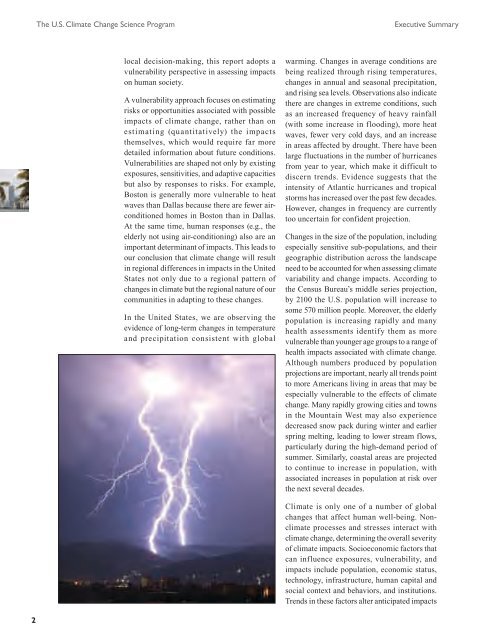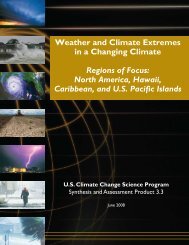Analyses of the Effects of Global Change on - US Climate Change ...
Analyses of the Effects of Global Change on - US Climate Change ...
Analyses of the Effects of Global Change on - US Climate Change ...
Create successful ePaper yourself
Turn your PDF publications into a flip-book with our unique Google optimized e-Paper software.
2<br />
The U.S. <strong>Climate</strong> <str<strong>on</strong>g>Change</str<strong>on</strong>g> Science Program Executive Summary<br />
local decisi<strong>on</strong>-making, this report adopts a<br />
vulnerability perspective in assessing impacts<br />
<strong>on</strong> human society.<br />
A vulnerability approach focuses <strong>on</strong> estimating<br />
risks or opportunities associated with possible<br />
impacts <str<strong>on</strong>g>of</str<strong>on</strong>g> climate change, ra<str<strong>on</strong>g>the</str<strong>on</strong>g>r than <strong>on</strong><br />
estimating (quantitatively) <str<strong>on</strong>g>the</str<strong>on</strong>g> impacts<br />
<str<strong>on</strong>g>the</str<strong>on</strong>g>mselves, which would require far more<br />
detailed informati<strong>on</strong> about future c<strong>on</strong>diti<strong>on</strong>s.<br />
Vulnerabilities are shaped not <strong>on</strong>ly by existing<br />
exposures, sensitivities, and adaptive capacities<br />
but also by resp<strong>on</strong>ses to risks. For example,<br />
Bost<strong>on</strong> is generally more vulnerable to heat<br />
waves than Dallas because <str<strong>on</strong>g>the</str<strong>on</strong>g>re are fewer airc<strong>on</strong>diti<strong>on</strong>ed<br />
homes in Bost<strong>on</strong> than in Dallas.<br />
At <str<strong>on</strong>g>the</str<strong>on</strong>g> same time, human resp<strong>on</strong>ses (e.g., <str<strong>on</strong>g>the</str<strong>on</strong>g><br />
elderly not using air-c<strong>on</strong>diti<strong>on</strong>ing) also are an<br />
important determinant <str<strong>on</strong>g>of</str<strong>on</strong>g> impacts. This leads to<br />
our c<strong>on</strong>clusi<strong>on</strong> that climate change will result<br />
in regi<strong>on</strong>al differences in impacts in <str<strong>on</strong>g>the</str<strong>on</strong>g> United<br />
States not <strong>on</strong>ly due to a regi<strong>on</strong>al pattern <str<strong>on</strong>g>of</str<strong>on</strong>g><br />
changes in climate but <str<strong>on</strong>g>the</str<strong>on</strong>g> regi<strong>on</strong>al nature <str<strong>on</strong>g>of</str<strong>on</strong>g> our<br />
communities in adapting to <str<strong>on</strong>g>the</str<strong>on</strong>g>se changes.<br />
In <str<strong>on</strong>g>the</str<strong>on</strong>g> United States, we are observing <str<strong>on</strong>g>the</str<strong>on</strong>g><br />
evidence <str<strong>on</strong>g>of</str<strong>on</strong>g> l<strong>on</strong>g-term changes in temperature<br />
and precipitati<strong>on</strong> c<strong>on</strong>sistent with global<br />
warming. <str<strong>on</strong>g>Change</str<strong>on</strong>g>s in average c<strong>on</strong>diti<strong>on</strong>s are<br />
being realized through rising temperatures,<br />
changes in annual and seas<strong>on</strong>al precipitati<strong>on</strong>,<br />
and rising sea levels. Observati<strong>on</strong>s also indicate<br />
<str<strong>on</strong>g>the</str<strong>on</strong>g>re are changes in extreme c<strong>on</strong>diti<strong>on</strong>s, such<br />
as an increased frequency <str<strong>on</strong>g>of</str<strong>on</strong>g> heavy rainfall<br />
(with some increase in flooding), more heat<br />
waves, fewer very cold days, and an increase<br />
in areas affected by drought. There have been<br />
large fluctuati<strong>on</strong>s in <str<strong>on</strong>g>the</str<strong>on</strong>g> number <str<strong>on</strong>g>of</str<strong>on</strong>g> hurricanes<br />
from year to year, which make it difficult to<br />
discern trends. Evidence suggests that <str<strong>on</strong>g>the</str<strong>on</strong>g><br />
intensity <str<strong>on</strong>g>of</str<strong>on</strong>g> Atlantic hurricanes and tropical<br />
storms has increased over <str<strong>on</strong>g>the</str<strong>on</strong>g> past few decades.<br />
However, changes in frequency are currently<br />
too uncertain for c<strong>on</strong>fident projecti<strong>on</strong>.<br />
<str<strong>on</strong>g>Change</str<strong>on</strong>g>s in <str<strong>on</strong>g>the</str<strong>on</strong>g> size <str<strong>on</strong>g>of</str<strong>on</strong>g> <str<strong>on</strong>g>the</str<strong>on</strong>g> populati<strong>on</strong>, including<br />
especially sensitive sub-populati<strong>on</strong>s, and <str<strong>on</strong>g>the</str<strong>on</strong>g>ir<br />
geographic distributi<strong>on</strong> across <str<strong>on</strong>g>the</str<strong>on</strong>g> landscape<br />
need to be accounted for when assessing climate<br />
variability and change impacts. According to<br />
<str<strong>on</strong>g>the</str<strong>on</strong>g> Census Bureau’s middle series projecti<strong>on</strong>,<br />
by 2100 <str<strong>on</strong>g>the</str<strong>on</strong>g> U.S. populati<strong>on</strong> will increase to<br />
some 570 milli<strong>on</strong> people. Moreover, <str<strong>on</strong>g>the</str<strong>on</strong>g> elderly<br />
populati<strong>on</strong> is increasing rapidly and many<br />
health assessments identify <str<strong>on</strong>g>the</str<strong>on</strong>g>m as more<br />
vulnerable than younger age groups to a range <str<strong>on</strong>g>of</str<strong>on</strong>g><br />
health impacts associated with climate change.<br />
Although numbers produced by populati<strong>on</strong><br />
projecti<strong>on</strong>s are important, nearly all trends point<br />
to more Americans living in areas that may be<br />
especially vulnerable to <str<strong>on</strong>g>the</str<strong>on</strong>g> effects <str<strong>on</strong>g>of</str<strong>on</strong>g> climate<br />
change. Many rapidly growing cities and towns<br />
in <str<strong>on</strong>g>the</str<strong>on</strong>g> Mountain West may also experience<br />
decreased snow pack during winter and earlier<br />
spring melting, leading to lower stream flows,<br />
particularly during <str<strong>on</strong>g>the</str<strong>on</strong>g> high-demand period <str<strong>on</strong>g>of</str<strong>on</strong>g><br />
summer. Similarly, coastal areas are projected<br />
to c<strong>on</strong>tinue to increase in populati<strong>on</strong>, with<br />
associated increases in populati<strong>on</strong> at risk over<br />
<str<strong>on</strong>g>the</str<strong>on</strong>g> next several decades.<br />
<strong>Climate</strong> is <strong>on</strong>ly <strong>on</strong>e <str<strong>on</strong>g>of</str<strong>on</strong>g> a number <str<strong>on</strong>g>of</str<strong>on</strong>g> global<br />
changes that affect human well-being. N<strong>on</strong>climate<br />
processes and stresses interact with<br />
climate change, determining <str<strong>on</strong>g>the</str<strong>on</strong>g> overall severity<br />
<str<strong>on</strong>g>of</str<strong>on</strong>g> climate impacts. Socioec<strong>on</strong>omic factors that<br />
can influence exposures, vulnerability, and<br />
impacts include populati<strong>on</strong>, ec<strong>on</strong>omic status,<br />
technology, infrastructure, human capital and<br />
social c<strong>on</strong>text and behaviors, and instituti<strong>on</strong>s.<br />
Trends in <str<strong>on</strong>g>the</str<strong>on</strong>g>se factors alter anticipated impacts




